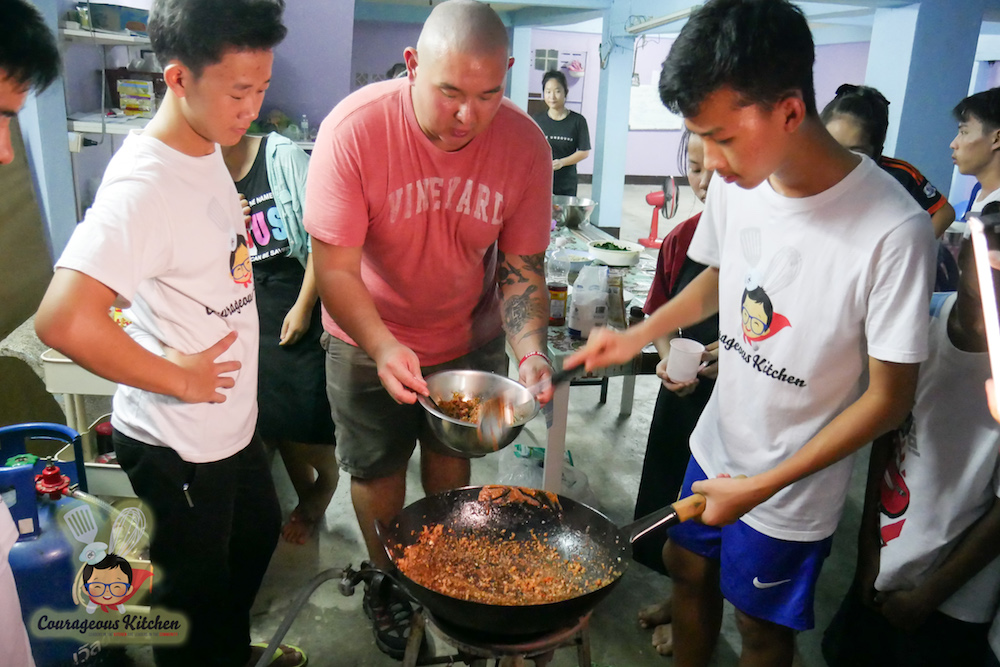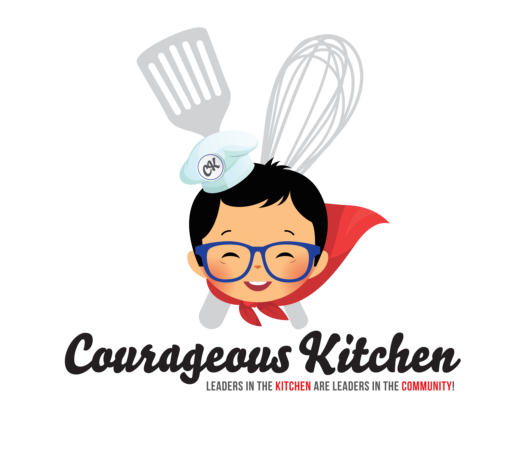We first met Chef Josh Venne a few years ago when he was touring the world. He made a stopover in Bangkok (one of his favorite cities) and reached out to us. His passion for service, culture, and food deeply aligned with our mission, and naturally he dove right in the kitchen and instantly became part of our Courageous Kitchen family.
We wanted you to get to know him, and asked him to share his story with us. In the interview below he gets candid, reminding us why it’s so important for us to share stories of overcoming struggle with our young leaders. Journeys from tragedy into triumph like Josh’s, inspire us, and give much needed hope to our students.
Read below to learn more about Chef Josh and see why he exemplifies courage in every way!
Q: I love how you’re making a name for yourself in an unconventional way. How long did it take you to get to this point?
So glad to hear it! I started cooking around the age of five for my siblings, and used it as a great stress reliever. I was interested in food very early and essentially wanted to be able to cook and eat every thing possible. When I was 15 I realized I wanted to pursue a career in food which was actually quite lucky. Some people take a lot longer so I was able to focus early and get lots of experience. Since then I have worked in some 25+ kitchens in five states in the USA. I have also traveled to 40+ countries for food research, and that’s really given me a huge base of experience and probably given me a good deal of an edge on my competition in the USA.
Many people are becoming more and more familiar with obscure cuisines. Take Thai food for example, there is so much more to it than just curries and papaya salad. Although I love the mainstays such as those, the more people learn about different cuisines and culture, the more I can cook things out of their normal comfort zone.
Q: What got you interested in food and sharing it with others, and when did you realize you had a knack for it?
I am heavily self-taught but I also graduated from the Culinary Institute of America, highly regarded as the best culinary school in the USA and one of the best in the world. However class learning is no replacement for experience, so I believe I have a good collection of both.
“It gave me a sense of purpose and satisfaction that not much else did.”
When I was younger, often times I would be forced to cook for myself and sometimes my siblings out of necessity. I would let friends try my items and got a great sense of pleasure from that. I also starting working at a pizza place in my young teenage years so that was a great source of pleasure as well. We wouldn’t cook much from scratch, but sometimes when we would run out of things made not in house, for example alfredo sauce, I remember making it from scratch, and completely baffling co-workers. After an especially stressful day at home, I would make large batches of things like Shepard’s pie and Bolognese. It was always way too much so I would gift it to friends. I realized I had a special gift to be able to not only taste items and make them my own, but that I also needed to share my gift with as many people as I could. It gave me a sense of purpose and satisfaction that not much else did.
Q: As a first-gen Lao American, I never wanted to embrace my Asian identity until I was much older. Have you always been a proud Asian American, or has it been a slow realization?
My mother was born in Korea, and had a pretty horrific childhood that plagued her entire life, and ultimately led to her death when I was 17, of a heroin overdose. She just couldn’t escape the darkness that followed her. She was adopted around age 8 I believe, to a single Irish woman who taught English in Massachusetts. My father was born in the USA to a German immigrant. Some of his siblings were born in the USA, and some in Germany.
I wouldn’t say I proudly identify as either German or Korean, but as an amalgamation of the both. Culturally I grew up in German influenced Massachusetts, with a little Irish culture peppered in. Korean culture wasn’t present because as my mom left when she was so young. We would occasionally go to the Korean market and get lots of panchan kimchee, and spicy marinated shiso leaves (my favorite), but that’s about it. Traveling around the world, and especially Asia, was certainly influenced by that.

But mostly I grew up eating American food with Massachusetts and German influence. Pasta, potatoes with kielbasa, schnitzel, German potato salad, sauerbraten, etc. The biggest influence is probably coastal Massachusetts. So I often cook seafood, lobster boils, and Portuguese influenced stews. Korean and German food make their way into my cuisine but not super often.
Q: Courageous Kitchen works with several refugee youth providing food education and teaching basic nutrition skills. What advice can you give to some of our students who may be in a situation similar to what your family experienced?
“Positivity breeds opportunity.”
Just keep pushing forward. Focus on the positive and try to ignore the negative. Positivity breeds opportunity. No one wants to take a chance on someone being negative and sad. Try to do things that advance your life, career, and display the positive parts of your day and feelings. It will help if you surround yourself with other positive people and never look back.
Q: Can you tell me what being courageous means to you?
Being courageous means to be brave in the face of danger and opposition. Life will only get harder, so I like to face the hardships head on to conquer them. Being courageous means getting out of your comfort zone and doing things that can be frightening. It also means going against the grain even if people don’t like it or approve. It also means being somewhat selfish at times.
For example, some people may not appreciate being served fish or other meat with the head still on. I will do whatever is needed to keep a dish enjoyable and authentic. It may not be well received by the majority, but if it is true to what makes the dish memorable for me, I do it. This keeps me innovating and pushing to educate and help people explore culture through cuisine.
Q: What have been the highlight moments of your culinary career? Alternatively, what have been the most challenging?
Catering my first solo wedding when I was 21, I was faced with every possible obstacle. The presents got stolen, the power went out, we were missing tons of ingredients, guests stole someone else’s plate while they were in the restroom, etc. but I still made it happen.
Taking my first solo trip to Taiwan was eye-opening. I realized I didn’t need a friend to travel with, and since then I’ve been to over 40 countries. So my highlight would be the opportunity to taste awesome food I would have never been able to try in the USA. And, of course, the weird stuff, like dog, eggs fermented in horse urine, bats, tarantulas, etc.
Q: I know you’ve got a lot going on — i.e. private events, catering, traveling and cooking classes in the mix. What’s next for you?
Right now I am trying to secure a job in the private chef sector. Restaurant work in amazing and fun but not financially rewarding. I’m ready to stay somewhat permanent for a bit and chip away at my student loan debt. In five years I’d love to be debt free, and starting to save to open my own restaurant. I’d like to focus on fast casual so more people can enjoy my food rather than fine dining. I’d also liked to be married or almost married with kids in the near future.
Q: Can you share your favorite recipe with our readers?
This is tricky, but I will share my scallion pancake recipe that really carried The Beacon Bite, the food trailer I previously co-owned in Beacon, NY. It is a yeast risen pancake that acted as a vehicle for our Korean marinated pork wrap.
- All purpose flour, one part
- Bread flour, three parts
- Water, warm 1 part (by weight)
- Salt, 1 pinch
- Yeast, 1 tsp per cup of flour
- Thinly sliced scallions
- Sauce made of soy, sesame oil, mirin, rice wine
Mix the yeast in the warm water. Mix the flour with salt in a mixer or by hand. Pour in the water and mix gradually. If it needs a little water or flour to adjust consistency, add it. The dough should be homogenous and slightly sticky. Work the dough until the gluten is well developed and the dough bounces back almost fully when you stick your finger in.
Portion the dough into dough balls 3-6 ounces as desired. Roll nicely and rest on sheet tray while you cut the scallions and make the sauce.
Roll the dough ball into a kind-of flat circle, using a rolling pin and as little flour as possible. Brush the sauce on the entire surface facing you, and sprinkle lightly with scallions. Roll the dough up tight, into a long snake. Then coil the dough onto itself and squish it together. The last tip may need a pinky finger full of sauce to stick. Flatten the dough out with your hand and roll again into a perfect circle again using as little flour as possible. They may need to rest a bit before to let the gluten relax.
Cook the pancake on a flattop or pan with a little cooking oil. Enjoy with the sauce you made for dipping, or stuff as a wrap with meat, vegetables, mayo, etc. At the Beacon Bite we did a spicy gochujang marinated pork shoulder with sesame carrot slaw and toasted chili mayo.
We are grateful to call Chef Josh Venne a good friend, and thankful to him for sharing, and serving our community with his whole heart. His love of adventure shines through in his cooking, his infectious smile, and his zest for life.
To connect with Chef Josh, find him on instagram as @jawshey.
Interview by Christy Innouvong






